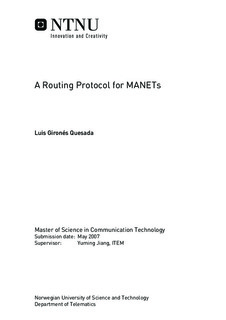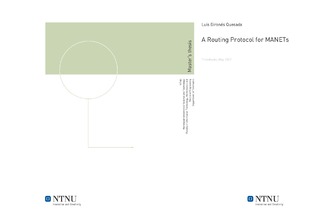| dc.description.abstract | In this master thesis there has been a description of what MANETs are and why they are so interesting. Because of its characteristics, the tradicional routing protocols for wired networks are not advisable for them. A specific routing protocol for MANETs is necessary. In this thesis the main groups of these protocols have been explained and some of the most commonly used of them were studied. We saw that each protocol is better in a specific environment. None of them are perfect for all the ranges of nodes mobility, traffic, number of nodes, etc. The two main groups of protocols studied are the proactive and the reactive ones. The main characteristic of the proactive is that each node maintains a route to every node in the network. Besides, it periodically updates this information. No matter if there is communication between the nodes or not. As representative examples of proactive protocols, OLSR and DSDV were described here. On the other hand, in the reactive ones the nodes only calculate the routes between those nodes that want to communicate. This kind of protocols perform in a more efficient usage of the bandwith (which is very limited in the MANETs medium) and the resources of the nodes. However, as a drawback, when the route is not available yet, the delay to achieve it can be great. The reactive protocols choosen here to be studied were AODV and DSR. In the reactive, the main problem is the delay to achieve a new route. In the proactive, it is the high usage of resources and bandwith when it is not necessary. Both, reactive and proactive also have the problem of the scalability. To solve these problems, a new kind of protocols appeared: the hybrid ones. A hybrid routing protocol combines both, the proactive and reactive to achieve better performance. The most popular of them is ZRP and its operation was described here too. None of the existing protocols are suitable for a MANET with a large number of nodes, each one of them with a different velocity and traffic. ZRP solves in part the problem of the scalabilty, but under different patterns of traffic and nodes velocity performs worse than the OLSR, DSR and AODV. Understanding the strengths and weaknesses of each protocol, a new one was proposed. The objective of this new protocol was to be suitable to MANETs with nodes moving freely, with different ranges of speed and traffic. Also, another objective was to improve the scalability of the reactive and proactive protocols. The protocol proposed here was called Penaguila. As ZRP and other hybrid routing protocols, it is based on having some nodes working in proactive mode creating areas, and comunicating this areas with other nodes working in reactive mode. The difference between Penaguila and ZRP, is that Penaguila takes into acount the speed and traffic of each node. Therefore, Penaguila tries to have each node working in the mode more suitable for itself. Also, an evaluation of the OLSR, AODV, DSR, ZRP and Penaguila has been done. Since it was not possible to program Penaguila in NS-2 because of the short time to write the thesis, it was only feasible to do a qualitative study. In this study the advantages and disadvantages of each protocol were exposed and the concluision was that Penaguila can outperform the existing protocols when: A) The network is large, since it is a hierarchical routing protocol. B) The nodes have very different speeds and amount of traffic. | nb_NO |

